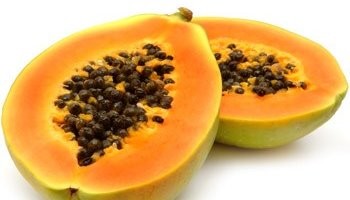
Did You Know This about Papaya
Botanical name: Carica papaya
Native to southern Mexico and Central America, papaya is now cultivated in most tropical regions, including Hawaii, where it was introduced in the early 1800s. Sometimes known as a tree melon or pawpaw, papaya is known not just for its rich sweet flavor, but also for its use as a meat tenderizer.
Initially green and somewhat bitter in taste, papayas are butter-yellow when fully ripe and shaped like a pear. Their pale-orange flesh has dozens of small, black, gelitonous seeds at the center, similar to a melon.
Unripe papaya is used in some areas of the world as a vegetable substitute, but is not recommended as a food when green, unless cooked. Recommended ways to eat papaya includes its juice, which is sometimes added to other natural fruit juices because of its pleasing taste, but it's also wonderful in salads, salsa, and, of course, all by itself.
Health Benefits of Papaya
Vitamin C is one of the strong points of papaya, providing a whopping 144% of the daily recommended value per serving, which is great as an infection fighter as well as a free radical-scavenging antioxidant. Other vitamins include 31% of the daily value in vitamin A, required for healthy skin, mucous membranes, and vision, and especially effective against macular degeneration. Papaya provides 13% of the DRV in folate, and good amounts of fibre and potassium, a cell and body fluid component that helps control heart rate and blood pressure.
The B vitamins in papayas such as folic acid, pyridoxine (vitamin B6), riboflavin, and thiamine (vitamin B1) are called "essential" because they're required by your body, but not produced by your body, so they need an outside source to provide what is needed to metabolize - that's why including foods like papaya in your diet is important.
Papaya is a natural remedy for many ailments, including atherosclerosis, heart disease, and rheumatoid arthritis, and helps keep your digestive and immune systems healthy. Papaya also contains the flavonoid beta carotene, which studies have proven to help protect against lung and mouth cancers. Other flavonoids, namely lutein, zeaxanthin, and cryptoxanthins, have potent antioxidant properties against free radicals that can wear down your body and cause premature aging and degenerative diseases.
Papayas contain 212 amino acids and several enzymes, including papain, a proteolytic enzyme that has an anti-inflammatory effect on the stomach, including swelling and fever that can develop post-surgery. Papain helps proteins digest faster, which discourages acid reflux, and has demonstrated effectiveness in treating ulcers and even relieving irritable bowel syndrome. Papaya seeds have been used in folk medicine to treat parasite and ringworm infections.
However, consume papayas in moderation because they contain fructose, which may be harmful to your health in excessive amounts.
Allergies and side effects
Papaya releases a latex fluid when not ripe, possibly causing irritation and an allergic reaction in some people.
Excessive consumption of papaya may cause carotenemia, the yellowing of soles and palms, which is otherwise harmless. However, a very large dose would need to be consumed; papaya contains about 6% of the level of beta carotene found in carrots (the most common cause of carotenemia).
Papaya Fun Facts
Papayas were first referenced in 1526 by the Spanish chronicler Oviedo, after discovering this fruit on the Caribbean coasts of Panama and Colombia. Christopher Columbus is said to have called papayas the "fruit of the angels."
India is worlds largest producers of Papayas with a total production of 5.5 million tons and Brazil is the second largest producers with 1.6 million tons. There is a wide variety of papaya which is grown in India as mentioned below -